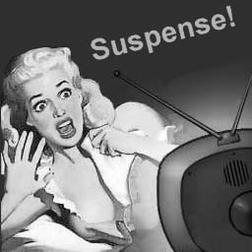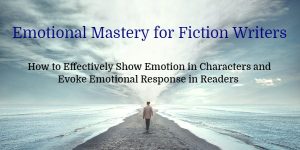Action That Evokes Emotion in Your Readers
Have you ever read a passage in a novel that made you cry? Stirred up indignation? Real terror? I am often moved by passages I read in both fiction and nonfiction. Masterful writers can wrench emotional reaction from me even with random passages.
We’re told to get readers to bond with our protagonist within the first couple of pages, something few writers can do well. Yes, we might get readers interested in our characters and even riveted by their personalities and actions in the opening scenes, but do we truly care for them? Depending on your genre and story, you might not want readers to care for your protagonist all that much (at the start).
As we grow attached to characters throughout the reading of a great novel, we care more about them. And that makes it easier for emotion to be evoked in us. All along the way, a writer must carefully manipulate readers’ emotion, in a deliberate fashion, to try to get them to feel what he wants them to feel.
Factor in Action
When it comes to evoking emotion in readers, we go beyond the showing and telling of emotions in our characters. A huge element that sparks emotion in us is action. Watching what characters do, how they behave, the choices they make, the conversations they have—all can be potent triggers of emotion in readers.
When adept writers show action in a cinematic way, with characters acting, reacting, and processing amid sensory details and vivid description, readers are transported into a scene, as if they are there, living vicariously through the characters. Readers are willing and ready to suspend their disbelief and pull down their walls, making themselves vulnerable to an emotional experience that might be powerful.
 Some readers read for the suspenseful ride. Like my husband and kids, they eagerly climb into seats on roller coasters—they’ll even wait two hours to experience a two-minute ride—just to get scared out of their wits. Some readers are perfectly fine crying, feeling miserable, aching in commiseration as they go on a difficult journey with a fictional character they love.
Some readers read for the suspenseful ride. Like my husband and kids, they eagerly climb into seats on roller coasters—they’ll even wait two hours to experience a two-minute ride—just to get scared out of their wits. Some readers are perfectly fine crying, feeling miserable, aching in commiseration as they go on a difficult journey with a fictional character they love.
Why do so many people love to do this? I don’t know. I can only speak for myself. There is something wonderful, magical, and sublime about being made to feel deeply about something outside my normal routine, my normal life. Stories that remind me of what being human is all about, what love is, what loyalty is, what hope is, what being victorious looks like lift me up, confirm my humanity, bring deeper meaning to my own life.
So when you are considering how to move your readers emotionally, don’t limit yourself to showing emotion in your characters. Be sure to consider how you are presenting the action of your plot in ways that have emotional impact. And that’s really found in the plot itself.
What good is it for you to have empathetic characters with intense inner conflict and moral dilemmas, but all they do is sit around, drink coffee, text their friends, and worry about what to wear?
Situations and settings and sensory details have great potential to evoke emotion in readers, so push yourself to put your characters in places and predicaments that will set the stage for high emotional content.
Instead of thinking, “I want my reader to feel sad,” how much more masterful would it be to dig deep into the many emotional nuances we experience when any given event occurs.
A New Online Course All about Emotion!
Mastering the emotional craft of fiction is perhaps the most difficult challenge facing a writer. And the most important and yet overlooked.
Readers read to care. They read to feel.
Readers of fiction aren’t reading to acquire facts, such as they might do when studying a nonfiction book. They read to be entertained, affected. They read to be tense, laugh, worry, get excited. In other words, they read to feel something.
If we writers don’t succeed in making our readers feel something, we fail. If they don’t feel what we want them to feel, we fail.
To be an effective writer, we must master the emotional challenge of our stories. It won’t do to hope we will move our readers in some way. It won’t do to hope we get across our characters’ emotions.
If we want to be masterful writers, we have to become a master of emotion.
 This is what this course is going to examine. There is no magic formula to mastering this skill. Being intuitive and sensitive can help. Being in touch with your own feelings can help. Studying great novels to see how other writers pull emotions out of hats can help.
This is what this course is going to examine. There is no magic formula to mastering this skill. Being intuitive and sensitive can help. Being in touch with your own feelings can help. Studying great novels to see how other writers pull emotions out of hats can help.
But it takes even more than all that.
In this course, you’ll be given tools to show emotions in your characters. You’ll be given techniques to help spark emotional response in your readers. What is going to bring it all together for you is practice. Study and practice. And you’ll have exercises in this course to help you put into practice what you learn.
There are two facets of emotion in fiction: conveying what your character is feeling and evoking emotion in your reader. We’ll look at these two facets separately and in depth. Yet, they are intrinsically connected.
Emotional mastery requires writers to set up the dynamics of a scene in such a visual, textural way that readers can’t help but feel what they are meant to feel. Understanding that emotional mastery requires a twofold approach—the emotional landscape of both the character and the reader—is the first step.
Want to learn how to become a masterful wielder of emotion in your fiction? Enroll in my new online video course, Emotional Mastery for Fiction Writers!
 You’ll get lifetime access to all the videos and more than three dozen downloadable assignments. And with a 30-day money-back guarantee, you have NOTHING to lose by jumping in. Sign up NOW (but remember: the course will not be live until September 1).
You’ll get lifetime access to all the videos and more than three dozen downloadable assignments. And with a 30-day money-back guarantee, you have NOTHING to lose by jumping in. Sign up NOW (but remember: the course will not be live until September 1).
This course will challenge you to become an “emotion master.” Are you ready and willing to go on this journey deep into emotional territory? If you want your characters to move your readers, take the plunge!
Listen to my discussion on how to show emotion in characters. There is so much to this topic!










